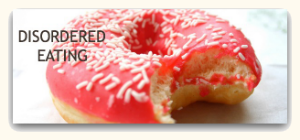
In my praxis I am usually confronted with the million dollar question “Is my behavior around food normal?”. This is a tricky question, and I try to honor it by using this example:
If one morning we wake up feeling sick, we can go to the doctor for a check up. He can run a number of tests and confirm or deny the presence of a virus or bacteria in our body. Depending on the germ or pathogen at hand, the doctor will prescribe medicine, rest, or will ask to perform more tests.
But in the field of eating psychology there is no such clear cut procedure: there are no viruses that cause binges or dieting, there are no medicines that can eliminate an eating disorder, nor are there any magic pills that can make us lose weight in a short time span (contrary to what many people believe and many companies advertise!).
This lack of black and white distinctions is hard to accept. I see it especially when mothers come to me concerned about the eating behavior of their teen daughters: is it ok for my daughter to be on a diet, especially since she is a little round at the hips? My daughter is not supper skinny, but I think she has lost too much weight…Is she anorexic or is she only going through a phase?
In order to answer these questions, we need to take a step back and try to understand Eating Psychology not as an exact science but as a broad spectrum of behaviors that stretch and overlap. Think for a minute of a rainbow: the color green doesn’t suddenly turn into blue, but rather goes through a series of turquoise tones. Likewise, in the field of Eating Psychology we can speak about different types of behaviors that create a broad eating spectrum.This spectrum is vast: it ranges form non problematic behaviors to disordered eating and classic clinical cases (see picture above).
Generally speaking, I prefer not to talk about “normal” behaviors but about “non problematic ones”. That is, a non problematic eating behavior is a habit or action that does not result in physical symptoms, pathologies or problems.
For example, if your teenager likes to have three cheese bagels for breakfast and this doesn’t result in considerable weight gain, stomach problems or less physical activity and concentration, then this eating behavior is non problematic – true, this might not be the healthiest breakfast in the universe, but it seems to work just fine for this teenager.
However, if I were to eat three cheese bagels for breakfast I’d probably spend all morning in the bathroom or with reflux, which would obviously be problematic for me. As we can see, what worked fine for a teenager can be my worst eating nightmare – this happens because there is a range of behaviors and habits that are acceptable for each one of us, and these will depend on many different factors (age, health level, culture of origin, level of physical activity, stress, etc).
Let’s look at the Eating Spectrum again. Before we encounter the classic eating disorders, there is a whole area of habits and behaviors that fall into a “grey” category: diets (which are not advisable unless supervised by a competent health practitioner), somatizations (stomach ache, fatigue, gas, etc) and other types of physical symptoms.
Just next to these behaviors and getting deeper into the spectrum we find disordered eating, which includes very restrictive or extreme diets, overeating, and sub-clinical symptoms.
Finally we reach the deeper part of the spectrum, which corresponds to clinical eating disorders, such as anorexia, orthorexia, bulimia, bulimiarexia. While each of these conditions has its own specific characteristics, from an Eating Psychology point of view these ailments belong in the same category (since they all represent a deeply distorted relationship to nourishment).
It’s important to notice that within this group we encounter EDNOS (Eating Disorders Not Otherwise Specified), which are behaviors that don’t fall into the classic textbook description of a disorder, yet they are just as harmful as their better-known counterparts.
An example of this could be a teenager who has bulimia and who starts seeing a practitioner for her disorder. Even if the teenager stops vomiting, it is important to understand that this girl might still engage in destructive behaviors around food (she might still binge and use laxatives sporadically), which clearly show that she is far from being recovered. While we might argue that her behavior no longer is classic bulimia, she still needs help in healing her relationship with nourishment.
As we can see, the eating spectrum offers us a much more comprehensive view of eating patterns and behaviors, and helps us understand the complexity of our relationship to food. The good news for us is that nothing is written in stone: the spectrum clearly allows for fluidity and flexibility: change in either direction is possible. There is ample room for re defining and healing our problematic behaviors.









